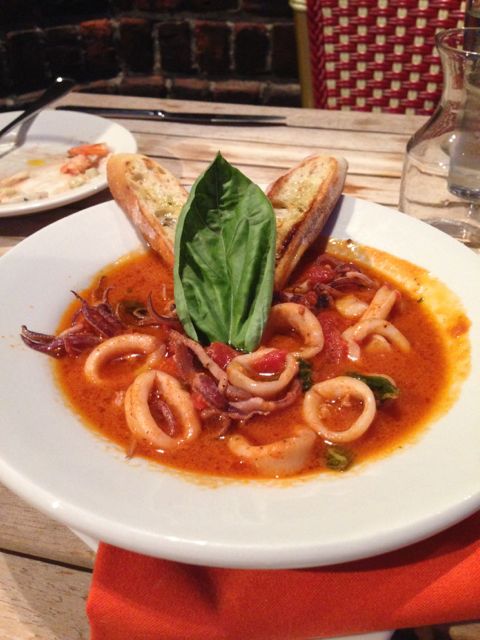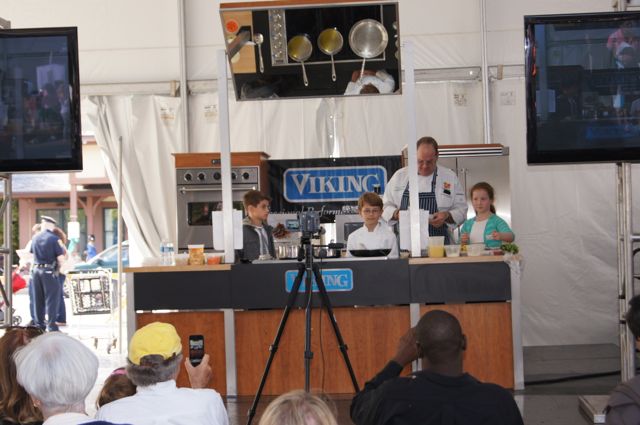Tomato Season ... What To Do When You Have Too Many
- Details
- Written by: Joanne Wallenstein
- Hits: 10604
 It's tomato season. And I know I can't enough of all the wonderful varieties that are available – red, yellow, heirloom, plum and cherry tomatoes abound. Ramsey's Farm in Scarsdale has a bounty of ripe tomatoes of all varieties for sale. What to do when you have too many? Before they go bad, consider these recipes from Emi Boscamp at the website Food 52 to use summer's beauties even when they've lost their firmness and are too soft to slice into a salad.
It's tomato season. And I know I can't enough of all the wonderful varieties that are available – red, yellow, heirloom, plum and cherry tomatoes abound. Ramsey's Farm in Scarsdale has a bounty of ripe tomatoes of all varieties for sale. What to do when you have too many? Before they go bad, consider these recipes from Emi Boscamp at the website Food 52 to use summer's beauties even when they've lost their firmness and are too soft to slice into a salad.
 Bruschetta:
Bruschetta:
Roast chopped tomatoes (or sliced cherry tomatoes) in the oven under they are caramelized. Then, melt some cheese on crostini (or keep it plain), throw on your tomatoes, season, and you have a delicious hors d'oeuvre to serve to all your summertime guests.
 Tomato Sauce:
Tomato Sauce:
Boil the tomatoes for a minute, peel them (here's how), chop them, then let them simmer into a tomato sauce, and add whatever seasonings you like. Go with garlic, anchovies, capers, and crushed red pepper for Pasta Puttanesca, or butter and onion for Marcella Hazan's Tomato Sauce.
Find more great recipes for summer tomatoes here:
(Photos and text courtesy of Food52)
Taiim Cellar: Now a Mediterranean Tapas Bar
- Details
- Written by: Joanne Wallenstein
- Hits: 5442
 Taiim Cellar in Scarsdale Village has reinvented itself as a Mediterranean wine and tapas bar and is now offering a selection of small plates that can be enjoyed inside the sleekly designed restaurant or outside at tables on Boniface Circle. The restaurant installed a new ventilation system in the kitchen and is now permitted to grill, widening the possibilities of what they can serve.
Taiim Cellar in Scarsdale Village has reinvented itself as a Mediterranean wine and tapas bar and is now offering a selection of small plates that can be enjoyed inside the sleekly designed restaurant or outside at tables on Boniface Circle. The restaurant installed a new ventilation system in the kitchen and is now permitted to grill, widening the possibilities of what they can serve.
We stopped by this week to sample the new offerings and were pleasantly surprised to find a  comfortable table outside and many appealing small plates from which to choose.
comfortable table outside and many appealing small plates from which to choose.
Along with a glass of chilled rose, we started by sharing an endive, watermelon, pickled celery, feta and mint in a yogurt dressing. It was crisp, crunchy and refreshing. Next up was the Fritto Misto –fried calamari, shrimp and fennel served with a rich truffle aioli sauce. Maitre D' Danny highly recommended the calamari in smoky tomato sauce shown here and the flavor was indeed unique.
However my favorite was the grilled skirt steak "Bavette" with cipollini onions in romesco sauce. Next time we'll be ordering two of those. It was sizzling and delicious.
Also on the menu are Taiim's signature selection of hummus, a good choice of panini sandwiches, plus salads and an extensive cocktail list. Prices are reasonable, portions are generous and it's easy to enjoy a quick bite.
Stop by for lunch or dinner and tell Danny you saw the write up on Scarsdale10583. Taiim Cellar, 11 Boniface Circle, Scarsdale, 914-723-6900, www.taiimcellar.com.


NaMu Steakhouse: Traditional and Fusion Korean Food
- Details
- Written by: Bruce Wells
- Hits: 6312
 After many months of teasing, NaMu Steakhouse Korean Bar & Grill has opened on Spencer Place between Häagen-Dazs and DeCicco's, and it is well worth the wait. The atmosphere is modern and soothing with a contemporary soundtrack, real candles, soft lighting and Zen-like decorations. It is family owned and run, and it shows with attention to detail and wonderful service.
After many months of teasing, NaMu Steakhouse Korean Bar & Grill has opened on Spencer Place between Häagen-Dazs and DeCicco's, and it is well worth the wait. The atmosphere is modern and soothing with a contemporary soundtrack, real candles, soft lighting and Zen-like decorations. It is family owned and run, and it shows with attention to detail and wonderful service.
To start, our waitress offered kimchi, a spicy pickled cabbage dish, bean sprouts, spicy summer squash and pickled vegetables. All were excellent and made fresh every day. The pickled vegetables were spicy, with thin slices of Jalapeño peppers and a slightly sweet finish. The kimchi was not super-spicy, but had plenty of flavor. The bean sprouts were great and simple, our favorite if we had to pick just one. They have a full liquor license and a well-stocked bar with Korean selections as well as all the favorites and they are looking into offering local craft beer.
The Mandu beef dumplings were excellent; handmade and pan fried to a perfect brown and crispy exterior. The beef filling mixed with vegetables was flavorful and when dipped in the accompanying light soy sauce, were some of the best dumplings we have encountered.
While the menu is not extensive, it offers both traditional Korean dishes and fusion dishes. Two examples are Korean tacos with a variety of fillings, and an appetizer of pineapple, asparagus or rice cakes on a skewer wrapped in bacon. They have a good selection of seafood dishes featuring scallops, salmon, shrimp, calamari and mussels. Meats include beef, chicken and pork.
We tried the Donkatzu, a Japanese dish of lightly bread pork cutlets served with a homemade soy based sauce that was excellent. The Pork Bulgogi, ordered spicy and served with rice, was amazing. Served on a combination stone and steel hot plate, it stayed piping hot to the very end. The pork was thinly sliced and tender, mixed with rice, was perfectly balanced and a highlight of the meal.
We were also offered Korean iced citron tea, which was a perfect complement to the spicy food and refreshing on a hot summer night. Citron is citrus fruit similar to a lemon, and the drink is like American lemonade, but not nearly as sweet with a more subtle light flavor. It is said to be a good digestive aid and healthful for its high vitamin C content. Worth trying and it could easily become a favorite.
Overall, the food is excellent, freshly prepared and high quality. The service was good and the atmosphere was relaxing and soothing. A good value for the quality and service offered. Highly recommended.
Namu Steakhouse
13 Spencer Place
Scarsdale, NY 10583
914-874-5655
http://www.namusteakhouse.com
https://www.facebook.com/namusteakhouse
Open Sun-Thurs 11am - 10pm, Fri & Sat 11am - 11pm
Celebrity Chefs to Duke it out at Food and Wine Festival in September
- Details
- Written by: Joanne Wallenstein
- Hits: 8167
 The SOWE Food & Wine Festival is a unique culinary celebration showcasing the talents of renowned restaurants, wineries, pit masters, cheese mongers, breweries, specialty culinary providers, spirits producers, chefs and culinary personalities. The events will take place in Mamaroneck on Saturday September 20th from 11 to 5 pm and in Scarsdale Village on Sunday September 21 from 11 am to 5 pm.
The SOWE Food & Wine Festival is a unique culinary celebration showcasing the talents of renowned restaurants, wineries, pit masters, cheese mongers, breweries, specialty culinary providers, spirits producers, chefs and culinary personalities. The events will take place in Mamaroneck on Saturday September 20th from 11 to 5 pm and in Scarsdale Village on Sunday September 21 from 11 am to 5 pm.
Hosted by the Scarsdale Chamber of Commerce and The Village of Mamaroneck, the Festival brings community together through food, wine, and beverage sampling, while generating awareness and raising funds to fight hunger, obesity and malnutrition. This fun-filled weekend also includes music concerts, book signings, cooking demos and even activities for kids.
SOWE 2014 will feature a variety of activities:
Friday, September 19, 2014: SOWE "Best Chef Battle" at Pepe Infiniti in White Plains from 7 pm to 10 pm
Saturday, September 20, 2014: SOWE Grand Culinary Village, featuring Healthy Eating/Healthy Living Pavilion, demonstration by pastry chef Jaques Torres, BBQ/Grilling Expo, Concert, Kids's Zone, & Food Truck Parade at Harbor Island Park in Mamaroneck from 11 am to 5 pm
Sunday, September 21, 2014 : SOWE Grand Tasting Village, featuring Healthy Eating/Healthy Living Pavilion, Music, and Kid's Zone, in the Village of Scarsdale (Chase Rd., Spencer Pl., Harwood Court, Boniface Circle & Woodland Rd.) from 11 am to 5 pm
A partial roster of celebrity chefs participating in this year's festival includes: Dan Amatuzzi, Wine Director, Eataly, NYC (named a "30 under 30 to Watch" by Forbes), and Nick Coleman, Oleologist (olive oil specialist), Eataly (NYC). They will be conducting a wine and olive oil demonstration. Also, attendees can view culinary demonstrations from Franklin Becker; Kamal Grant, Owner and Chef of Sublime Doughnuts, Atlanta; Joe (JJ) Johnson, Chef of The Cecil in Harlem, NYC (named a "30 under 30 to Watch" by Forbes); Nisa Lee; Rafael Palomino and Dave DiBari. Look for some of your favorite personalities to be added to the schedule at a later date.
SOWE introduces its lineup of renowned chefs, from across the country, for a chef face off: Chef Graham Elliot joins SOWE from Chicago, IL and brings a unique dining experience for all. Elliot, a cultured chef who has traveled the globe, as well as all fifty states, combines fine dining and exceptional creativity to all of his meals. Chef Elliot was named one of Food & Wine Magazine's "Best New Chefs" in 2004 and was featured on Crain's Chicago Business list of "40 Under Forty." His restaurant in Chicago, Graham Elliot Bistro, has captivated not only the city, but President Obama, who recently dined at the restaurant for an intimate birthday dinner. Elliot will face off with Rocco DiSpirito in SOWE's Chef Battle. Rocco DiSpirito is an award-winning chef and author of ten highly acclaimed cookbooks, including his newest #1 New York Times best seller The Pound A Day Diet and bestselling series Now Eat This! The Scotto Family (Marion, Elaina, Rosanna, and Tony, Jr.) will be judging the SOWE Best Chef Battle on September 19th.
SOWE will be hosting a chocolate lovers demonstration by Jacques Torres on Saturday, September 20th in Mamaroneck: For chocolate lovers, pastry chef Jacques Torres will be featuring his notorious, indulgent chocolate treats. His chocolate delicacies combine all natural ingredients, as well as traditional French techniques, to deliver the tastiest sensation. In 1986, Torres became the youngest pastry chef to receive the elite Meilleur Ouvrier de France (Best Craftsman of France) medal in pastry.
A sampling of restaurants partaking in SOWE 2014 includes: 8 North Broadway, 808 Bistro, Restaurant 42, ABC Cakes, An American Bistro, Artuso Pastry, Benjamin Steakhouse, BLT, Chutney Masala, Crabtree's Kittle House, Pinch, Dolphin, Enrico's Pastry Shop, Gaucho Grill, Havana Central Ridge Hill, Imagine Candy, Le Jardin Du Roi, Le Moulin, Longford's Ice Cream, Lu Lu's, Massa, Melting Pot, Palominos, Bistro Latino, Sonora, Parkway, Pete's Saloon, Pizza & Brew, Savona, Serafina, The Sneaky Chef, The Cookery's Dough Nation, Thyme, ZaZa's, Chef Johnson, and Dan Rooneys. Restaurants will be added daily, so please check out our website for updates.
SOWE provides live music including acts from: Gary U.S. Bonds, an American rock and roll rhythm and blues singer; Marshall Crenshaw, an American Top 40 singer; The Ramps; and Gill Parris, a Grammy-nominated rock, blues, jazz and pop guitarist.
An important part of the SOWE Food and Wine Festival is giving back to the local community. This year's beneficiaries include: WhyHunger, Scarsdale Volunteer Ambulance Corp., Food Bank for Westchester, Greyston Foundation, and others. SOWE is also excited to partner this year with the Culinary Institute of America (CIA), the world's premier culinary college, which will be providing cooking demonstrations and tasty samples from their world famous restaurants.
Wine Tasting at Taiim and Namu Opens in Scarsdale
- Details
- Written by: Joanne Wallenstein
- Hits: 4672
 Taiim Cellar in Scarsdale Village will host an evening of food and wine pairing with Dorit Segev, winemaker from Golan Heights Winery. This is an exclusive opportunity to meet Dorit Segev, taste the wines of Israel and enjoy delicious food at Taiim.
Taiim Cellar in Scarsdale Village will host an evening of food and wine pairing with Dorit Segev, winemaker from Golan Heights Winery. This is an exclusive opportunity to meet Dorit Segev, taste the wines of Israel and enjoy delicious food at Taiim.
Golan Heights Winery is one of Israeli's finest producers of wine. Founded in 1993, Golan Heights is famous for producing internationally renowned wine that rivals the wines of Tuscany and Bordeaux. In 2012, Golan Heights Winery was named New World Winery of the Year by the Wine Enthusiast Magazine.
Ms. Segev has been nominated by the Wine Enthusiast Magazine as the "New World Winery of the Year." Dorit has a bachelor's degree (B.Tech) in Biotechnology from Ort Braude in Markiel and a Post Graduate Diploma in Oenology from the University of Adelaide, South Australia. Doris first started working for the Golan Heights Winery in 2004 and after three years as a winemakers assistant in Australia, and then in July 2008 at Navarro Winery in the Anderson Valley, California. In January 2009, Dorit worked harvest at Vilafonte Winery in Stellenbosch, South Africa. Dorit then returned to Golan Heights Winery and joined the winemakers' team at Golan Heights Winery.
There will be two seatings on Sunday night July 20th at 5 pm and at 8 pm. The fee is $100 per person and space is limited. Please reserve by calling Taiim at 11 Boniface Circle at 723-6900 before July 15th.
Erion Hasko of Taiim Cellar invites you to enjoy the event to experience the the wines of Israel.
 Namu Korean Bar and Grill is now open seven days a week on Spencer Place in Scarsdale Village. The menu includes barbequed skewers of shortribs, steak, shrimp, chicken, scallops and pork priced at just $11 for two served rice, salads and Asian appetizers such as dumplings, spicy rice cakes, edamame and shumai all reasonable priced. Main courses come with miso soup and kimchi and inclue skirt steak, chicken bulgogi (tenderized in sweet soy marinade) teriyaki salmon steak and more. Another option is Rice Bibimbap a mixture of Korean style rice and assorted vegetables topped with beef, fish, chicken or vegetables. You can eat in or order out and delivery is free for orders of $20 or more. Give them a try and let us know what's good!
Namu Korean Bar and Grill is now open seven days a week on Spencer Place in Scarsdale Village. The menu includes barbequed skewers of shortribs, steak, shrimp, chicken, scallops and pork priced at just $11 for two served rice, salads and Asian appetizers such as dumplings, spicy rice cakes, edamame and shumai all reasonable priced. Main courses come with miso soup and kimchi and inclue skirt steak, chicken bulgogi (tenderized in sweet soy marinade) teriyaki salmon steak and more. Another option is Rice Bibimbap a mixture of Korean style rice and assorted vegetables topped with beef, fish, chicken or vegetables. You can eat in or order out and delivery is free for orders of $20 or more. Give them a try and let us know what's good!
Namu Steakhouse 
13 Spencer Place
Scarsdale, NY 10583
914-874-5655
https://www.facebook.com/namusteakhouse/










